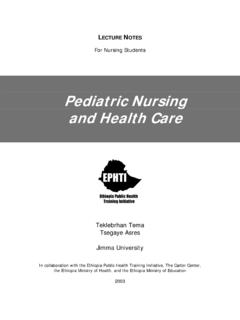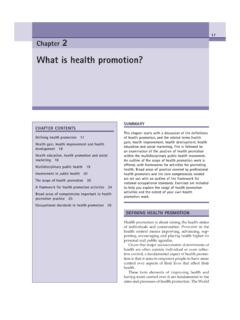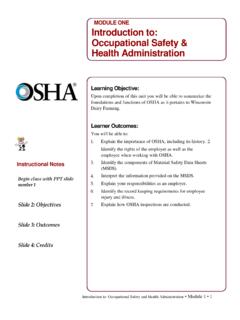Transcription of Metabolism - Jones & Bartlett Learning
1 THINK About ItVisit 7 Metabolism1 You are driving on the energy highway. You stop at the tollbooth. What kind of currency do you need to pay the toll?2 When you think of cell power, what comes to mind?3 What do you think is meant by the saying Fat burns in a flame of carbohydrate ?4 When it comes to fasting, what s your body s first priority?THINK About ItVisit 2671/20/10 7:34:39 AM Jones and Bartlett Publishers, LLC. NOT FOR SALE OR DISTRIBUTION268 Chapter 7 MetabolisMYour body is a wonderfully efficient factory. It accepts raw materials (food), burns some to generate power, uses some to produce finished goods, routes the rest to storage, and discards waste and by-products. Constant turnover of your stored inventory keeps it fresh. Your body draws on these stored raw materials to produce compounds, and nutrient intake replenishes the you ever wonder how your biological factory responds to changing supply and demand?
2 Under normal circumstances, it hums along nicely with all processes in balance. When supply exceeds demand, your body stores the excess raw materials in inventory. When supply fails to meet demand, your body draws on these stored materials to meet its needs. Your biological fac-tory never stops; even though a storage or energy-production process may dominate, all your factory operations are active at all , these processes are known as Metabolism . (See Figure ) Whereas some metabolic reactions break down molecules to extract energy, others synthesize building blocks to produce new molecules. To carry out metabolic processes, thousands of chemical reactions occur every moment in cells throughout your body. The most active metabolic sites include your liver, muscle, and brain : Fuel for WorkTo operate, machines need energy. Cars use gasoline for fuel, factory machinery uses electricity, and windmills rely on wind power.
3 So what about you? All cells require energy to sustain life. Even during sleep, your body uses energy for breathing, pumping blood, maintaining body temperature, delivering oxygen to tissues, removing waste products, synthesizing new tissue for growth, and repairing damaged or worn-out tissues. When awake, you need additional energy for physical movement (such as standing, walking, and talking) and for the digestion and absorption of does the energy come from to power your body s machinery ? Biological systems use heat, mechanical, electrical, and chemical forms of en-ergy. Our cells get their energy from chemical energy held in the molecular bonds of carbohydrates, fats, and protein the energy macronutrients as well as alcohol. The chemical energy in foods and beverages originates as light energy from the sun. Green plants use light energy to make carbohydrate in a process called photosynthesis.
4 In photosynthesis, carbon dioxide (CO2) from the air combines with water (H2O) from the earth to form a carbohy-drate, usually glucose (C6H12O6), and oxygen (O2). Plants store glucose as starch and release oxygen into the atmosphere. Plants such as corn, peas, squash, turnips, potatoes, and rice store especially high amounts of starch in their edible parts. In the glucose molecule, the chemical bonds between the carbon (C) and hydrogen (H) atoms hold energy from the When our bodies extract energy from food and convert it to a form that our cells can use, we lose more than half of the total food energy as any system (including the universe), the total amount of energy is constant. Although energy can change from one form to another and can move from one location to another, the system never gains or loses energy. This principle, called the first law of thermodynamics, is known as conserva-tion of Food energy to Cellular energyAlthough burning food releases energy as heat, we cannot use heat to power the many cellular functions that maintain life.
5 Rather than using combustion, Proteins(amino acids)Carbohydrates(sugars)Glucose &glycogenAmino acids &body proteinsFatty acids &lipidsFats(fatty acids)Molecular building blocksBIOSYNTHESISEXTRACTION OF ENERGYE nergyFigure 7. Metabolism . Cells use metabolic reactions to extract energy from food and to form building blocks for 2681/20/10 7:34:40 AM Jones and Bartlett Publishers, LLC. NOT FOR SALE OR DISTRIBUTION energy: Fuel For Work 269we transfer energy from food to a form that our cells can use. (See Figure ) This transfer is not completely efficient; we lose roughly half of the total food energy as heat as our bodies extract energy from food in three stages:3 Stage 1: Digestion, absorption, and transportation. Digestion breaks food down into small subunits simple sugars, fatty acids, monoglycerides, glycerol, and amino acids that the small intestine can absorb.
6 The circulatory system then transports these nutrients to tissues throughout the 2: Breakdown of many small molecules to a few key metabolites. Inside individual cells, chemical reactions convert simple sugars, fatty acids, glycerol, and amino acids into a few key metabolites (products of metabolic reactions). This process liberates a small amount of usable IIBreakdown ofmany small molecules toa few keymetabolites Aminoacids ATPADPG lucose andother sugarsSTAGES IN THE EXTRACTION OF ENERGY FROM FOODF atty acidsand glycerolStage IIIC omplete transfer of energy to a form usable by cellsElectron transportchainCell membraneMitochondrionCitricacidcyclee e Acetyl CoAProteinsCarbohydratesFatsStage IDigestion, absorptionand transport1/2O2H2 OATPC ytosol Electron transport chain Figure Energy extraction from food. In the first stage, the body breaks down food into amino acids, monosaccharides, and fatty acids.
7 In the second stage, cells degrade these molecules to a few simple units, such as acetyl CoA, that are pervasive in Metabolism . In the third stage, the oxygen-dependent reactions of the citric acid cycle and electron transport chain liberate large amounts of energy in the form of All chemical reactions within organisms that enable them to maintain life. The two main categories of Metabolism are catabolism and energy Energy contained in the bonds between atoms of a The process by which green plants use radiant energy from the sun to produce carbohydrates (hexoses) from carbon dioxide and Any substances produced during 2691/20/10 7:34:40 AM Jones and Bartlett Publishers, LLC. NOT FOR SALE OR DISTRIBUTION270 Chapter 7 MetabolisMStage 3: Transfer of energy to a form that cells can use. The complete breakdown of metabolites to carbon dioxide and water liberates large amounts of energy.
8 The reactions during this stage are responsible for converting more than 90 percent of the available food energy to a form that our bodies can is Metabolism ? Metabolism is a general term that encompasses all chemical changes occur-ring in living organisms. The term metabolic pathway describes a series of chemical reactions that either break down a large compound into smaller units (catabolism) or build more complex molecules from smaller ones (anabolism).4 For example, when you eat bread or rice, the GI tract breaks down the starch into glucose units. Cells can further catabolize these glucose units to release energy for activities such as muscle contractions. Conversely, anabolic reactions take available glucose molecules and assemble them into glycogen for storage. Figure illustrates catabolism and pathways are never completely inactive. Their activity continu-ally ebbs and flows in response to internal and external events.
9 Imagine, for example, that your instructor keeps you late and you have only five minutes to get to your next class. As you hustle across campus, your body ramps up energy production to fuel the demand created by your rapidly contracting muscles. As you sit in your next class, your body continues to break down and extract glucose from the banana you recently ate. Your body assembles the glucose into branched chains to replenish the glycogen stores you depleted while running across Cell is the Metabolic Processing CenterCells are the work centers of Metabolism . (See Figure ) Although our bodies are made up of different types of cells ( , liver cells, brain cells, kid-Amino acid catabolismalso produces ureaEnergyEnergyEnergyEnergyEnergy+++Ene rgyEnergyCATABOLIC REACTIONSANABOLIC REACTIONSG lycogenGlycogenGlucoseGlucoseGlucoseGlyc erolGlycerolAminoacidsAminoacidAminoacid Tr iglycerideTr iglycerideProteinProteinFattyacidsFattya cidsCO2 and H2 OFigure Catabolism and anabolism.)
10 Catabolic reactions break down molecules and release energy and other products. Anabolic reactions consume energy as they assemble complex pathway A series of chemical reactions that either break down a large compound into smaller units (catabolism) or synthesize more complex molecules from smaller ones (anabolism).catabolism [ca-TA-bol-iz-um] Any metabolic process whereby cells break down complex substances into simpler, smaller [an-A-bol-iz-um] Any metabolic process whereby cells convert simple substances into more complex The basic structural units of all living tissues, which have two major parts: the nucleus and the The primary site of genetic information in the cell, enclosed in a double-layered membrane. The nucleus contains the chromosomes and is the site of messenger RNA (mRNA) and ribosomal RNA (rRNA) synthesis, the machinery for protein synthesis in the The material of the cell, excluding the cell nucleus and cell membranes.















